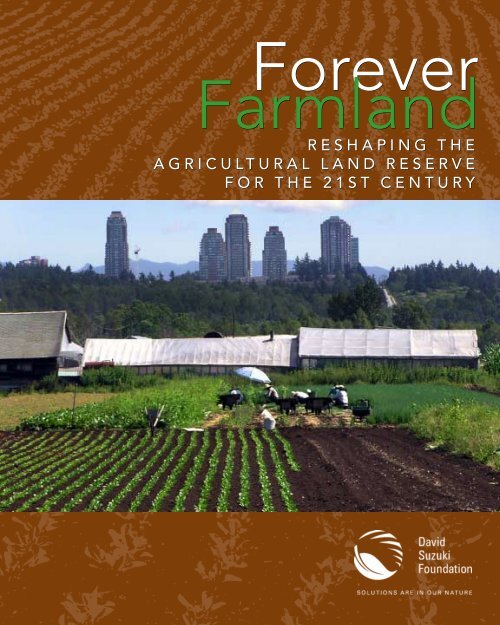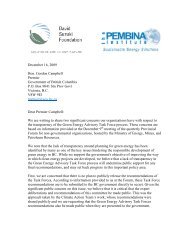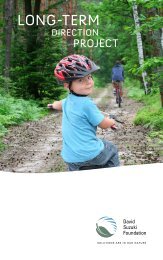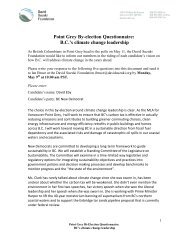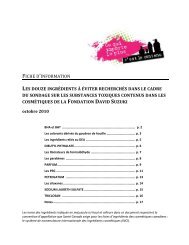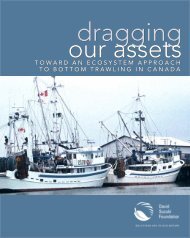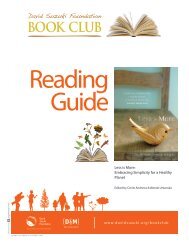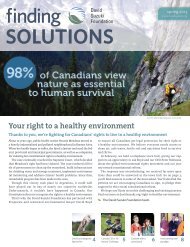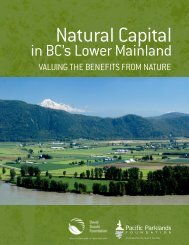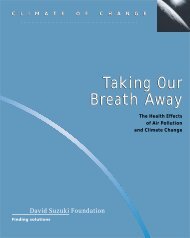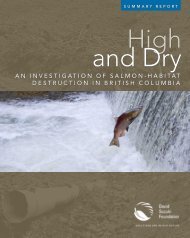Forever Farmland - David Suzuki Foundation
Forever Farmland - David Suzuki Foundation
Forever Farmland - David Suzuki Foundation
Create successful ePaper yourself
Turn your PDF publications into a flip-book with our unique Google optimized e-Paper software.
FOREVER FARMLAND 31<strong>Forever</strong><strong>Farmland</strong>RESHAPING THEAGRICULTURAL LAND RESERVEFOR THE 21ST CENTURYCHARLES CAMPBELL
Agriculture not only gives riches to a nation,but the only riches she can call her own.— Samuel JohnsonPeace River district near Fort Saint John
FOREVER FARMLAND 1ForewordFinancial advisors tell us wise planninginvolves making decisions todayoriented to our future needs. Thisapplies to decisions about personal capital aswell as to the natural capital we hold in trustfor future generations.The goal of the <strong>David</strong> <strong>Suzuki</strong> <strong>Foundation</strong>is to make Canada a leader in sustainable livingand environmental protection by 2030. Thisis an ambitious but realizable goal if governments,businesses and individuals makedecisions today about the kind of world wewant to leave for our children. This visionis captured in our document Sustainabilitywithin a Generation. Many of the policy toolsfor making this vision a reality already exist.A good example of land use planning orientedto the future can be found right here inBritish Columbia.In the early 1970s, the province of BritishColumbia designated good quality farmland inthe province as an “agricultural lands reserve”(ALR) where non-agricultural land use wouldbe strictly controlled. The rationale for doingso is clearly stated in the act that refers toagricultural lands as a “scarce and importantasset.” <strong>Farmland</strong> anywhere is natural capital –in B.C., it is recognized in legislation.The Agricultural Land Commission (ALC),which was established at the same time as theALR, has three very clear objectives: to preservefarmland in B.C. from other forms of development,to encourage farming, and to work withlocal levels of governments to fulfill thoseobjectives.Yet as this report shows, decisions regardingthe ALR remain as contentious as the day it wascreated. The very regions where urban populationgrowth and associated development isgreatest in the province are where there isstrong pressure to remove lands from the ALR.Losing farmlands to urban developmentinvolves more than losing farmers and theproductive capacity of the soil. BritishColumbians are accustomed to seeing a varietyof local produce in our markets. Businesseshave sprung up that are using the wide rangeof agricultural items grown in B.C. Farms thatproduce a wide variety of foods also protectwildlife habitat and support biodiversity. Thebest, most productive agricultural lands haveintrinsic values that should be protected intoperpetuity – once developed they can neverbe adequately recovered or restored.Protecting farmlands is only one part of thepuzzle of how to ensure agriculture provideshealthy and nutritious foods while protectingthe biodiversity and the quality of the land andwaters of this province. Yet the citizens of B.C.should be proud of the visionary land usepolicy the ALR represents. It is an importantaccomplishment – so we now must work toensure perceived short-term needs do noterode the long-term vision.Instead of whittling away at this importantcomponent of B.C.’s natural capital, we cantake decisive action to protect the long-termintegrity of agricultural lands. Action on therecommendations found in this report woulddo just that.Ann RowanDirector, Sustainability Program<strong>David</strong> <strong>Suzuki</strong> <strong>Foundation</strong>
2 FOREVER FARMLANDKey RecommendationsAgricultural land in B.C. is recognized to be a “scarce and important asset.”Decisions regarding this asset must be geared to protecting the best farmlandagainst other development in the long-term. This report recommends:• The Agricultural Land Commission Act and the Agricultural LandCommission’s annual service plan must be revised to ensure they areconsistent and clear in their commitment to protect agricultural landfrom other forms of development.• The application process for Agricultural Land Reserve (ALR) removals,subdivision, and non-farm use must be more open, transparent,and accountable.• The Agricultural Land Commission must move toward a morecomprehensive regional planning process and consider “community need”applications for removal only as part of a comprehensive review ofALR boundaries.• The provincial government must undertake or facilitate authoritativeresearch on a wide range of factors likely to impair the viability of farmingnow and in the future.• The provincial government must develop policies to support farmsand farming practices that contribute to the health of communities andthe environment.•Municipalities and regional districts must plan to protect existingagricultural land as a permanent legacy for future generations.For further detail regarding these recommendations, please see pages 25–27.
4 FOREVER FARMLANDProvincial politicians almost always say they are committed to maintainingthe ALR. In part, that’s because the public does not want our government tomeddle with it. A Viewpoints Research public opinion survey in 1997 found that90 per cent of British Columbians felt government should limit urban developmentto protect farmers and farmland. Seventy-two per cent believed it shouldbe difficult or very difficult to remove land from the ALR.However, controlling the pressure urban development puts on agriculturalland has never been easy. Smaller communities often resent the AgriculturalLand Commission’s intrusion into what they see as local affairs. As well, variousprovincial governments have been criticized for overruling Commission decisionsand undermining its mandate.Right now, explicit new guidelines in the Agricultural Land Commission’sservice plan direct the Commission to consider “community need” in vettingapplications to remove land from the ALR. The Commission has been restructuredto make it more “regionally responsive.” Several contentious applicationsCreated by Resource ManagementBranch, BC Ministry of Agriculture andLands, November 2005Agricultural Land Reserves0 100 200 400KILOMETRES
8 FOREVER FARMLANDLangleyIn addition, regulations provide detailed direction on such matters as permitteduses in the ALR, penalties for non-compliance and Commission procedures.While ALC annual reports have traditionally summarized achievements and setobjectives, in 2002, the government added a “service plan”, available on theCommission’s website, that provides additional direction, goals, and performancebenchmarks.The September 2005 three-year service plan states that a percentage ofCommission decisions to permit non-farm use and subdivision of the farmlandprotected by the reserve can “be approved on the basis of community need” aslong as “commission decisions do not significantly diminish the suitability ofland for agriculture.”For most its first 27 years, one group of five to seven decision-makers carriedout the Act’s mandate. They represented the province as a whole, to reflect thelong-term provincial need for agricultural land and to ensure decisions were notunduly influenced by local pressure.In 2000, the ALC was briefly amalgamated with the Forest Land Commissionand the Commission was loosely restructured along regional lines. In 2001, theamalgamation was reversed and the restructured Commission was dissolved. In2002 however, the government built on the regional model by installing six newthree-member regional panels. The new panels hear ALR applications only in theregion they represent.The government argues these changes are intended to address local frustrations.Notwithstanding its long history of working with municipal and regionalgovernments to try and address planning dilemmas, the Commission has oftenbeen seen as remote from and insensitive to local concerns. Applications werefrequently decided without Commissioners or staff visiting the land involved.Land-use challenges are vastly different in various parts of the province. Aswell, real and perceived short-term economic development needs outside majorurban centres can have a powerful influence on local decision-makers. They canalso be a huge factor in the erosion of the ALR.In practice, thesix three-memberregional panelsnow makesignificant ALCdecisions.Credibility depends on processThe current Act gives great latitude to the government and the Commission inhow it organizes its decision-makers. The Act requires that an “executive committeeof the commission is established, comprised of the chair of the commissionand the vice chairs.” It gives very broad powers for the Commission’sCabinet-appointed CEO (at this writing a vacant position), the chair of theCommission, or the executive committee to make unilateral decisions or todelegate decisions to Commission members or local governments.
FOREVER FARMLAND 9It also gives broad powers to the chair in how regional panels are configured.Section 11 of the Act states: “The chair of the commission may establish up to 6panels comprised of 2 or more members of the commission. The panels may beestablished according to geographic regions of British Columbia or according toany other criteria the commission may determine. The chair of the commissionmay designate a vice chair of the commission to chair a panel.”In practice, the six three-member regional panels now make significant ALCdecisions. The executive committee of the chair and six vice-chairs is intended toprovide provincial context, but its deliberations and influence on panel decisionsare invisible to the general public.While the increasingly local and regional outlook of the Commission hasbeen welcomed by some local governments, the shift begs the question ofwhether the long-term provincial interest in preserving agricultural land issufficiently considered. The choice to compose panels of local people likely tohave a history with the industry and governments they regulate is also an issue inthis regard.The commission’s decisions are often needlessly perfunctory. When theCommission asks itself whether its decision will “significantly diminish thesuitability of land for agriculture,” is it a question that applies only to the decisionat hand in the current moment, or are they considering the cumulativeeffect of several decisions over a number of decades?The Commission’s own procedural rules are looser than those in the LocalGovernment Act, which are quite stringent in ensuring public business takesplace in a public manner. The Commission panels can limit public input. Itsmembers can meet privately with an applicant during routine site visits.As well, the small size of the panels also weakens accountability. A system inwhich five or seven people make a decision is less vulnerable than one wherethree individuals rule on the matter. Beyond an increased sample size, the reasonfor this is simple: when a decision-making body consists of three people, it’s veryeasy for two of them to come to a private agreement.In the case of critical land-use decisions, it’s important that deliberations becompletely transparent and that reasons for the ruling be fully articulated.Public, landowner, and local government confidence that the ALC will beconsistent, rigorous, and independent is critical to its success. Any governmentcommitted to “open, transparent and accountable” decision-making must givecareful consideration to these issues.THE ALR:recent threats& removalsPENTICTONThe City of Penticton wona partial victory with theAgricultural Land Commissionwhen the Commission allowedthe removal of two of threeparcels the city had assembledto develop sports facilities.However, in the November2005 civic election residentstossed the mayor out andrejected development of thefarmland in a referendum.Yet less than 48 hours afterthe election, the old councilstill voted to recommendanother exclusion from theALR of 7.2 hectares for aresidential subdivision despitethe objections of its ownagricultural advisorycommittee. At an ALC publicmeeting in January, opponentsof the exclusion complainedthat, although the developer’sconsultant made apresentation, critics ofthe plan were not permittedto speak. However, theALC subsequently rejectedthe application.
10 FOREVER FARMLANDBest land faces biggest riskFarmgate sales, ComoxThe ALC’s current service plan states that up to a tenth of a per cent of land inthe 4,760,000-hectare ALR can be removed in the 2005-06 to 2007-08 period tomeet “community need.” That could amount to 4,760 hectares – an area equivalentto 41 per cent of the City of Vancouver.Pressure for removal is greatest, of course, close to major population centres,where the most productive farmland is also predominantly located. The ALC’s1998 Planning for Agriculture guide states that more than 80 per cent of B.C.’spopulation is located in two regions that produce 78 per cent of its gross farmreceipts. Those regions, centering on the south coast and the Okanagan, comprisejust 2.7 per cent of our provincial land base. However, they contain muchof the province’s prime land. Even the less productive land in these areas isessential to provide for both agriculture’s growth and its complex, interdependentrange of needs.If the Commission excluded prime land (class 1, 2 and 3 land, which comprisesjust a fifth of the reserve) at the maximum rate in the service plan guidelineon an ongoing basis, B.C. would lose five per cent of its prime agriculturalland every 30 years.What’s more, the tenth of a per cent removal provision does not apply toexclusions deemed to be partly, but not mainly, intended to meet “communityneed.” Decisions made to remove ALR land because of “poor agricultural suitability”as a result of a problematic location or lower land quality won’t befactored into the amount.How does the potential rate of loss compare with the circumstances thatprecipitated the creation of the reserve in 1973? Figures cited by governmentof the day suggested 4,000 to 6,000 hectares of mostly prime agricultural werebeing lost to development each year. Provincial Department of Agriculturestatistics at the time indicated 20 per cent of the Lower Fraser Valley’s arableland had been developed and this area alone was losing 1,200 hectares per year. 3With the ALR, the rate at which B.C. is losing its most valuable agriculturalland has slowed. Yet one critical question remains: When will the losses stop?After all, the significant pace of growth in British Columbia shows no signs ofabating. Between 1986 and 2001, Greater Vancouver expanded at an annual rate2.6 per cent, rivalling such Third World mega-cities as Jakarta, Indonesia, andKarachi, Pakistan. Given our need to protect agricultural land for an indefinitefuture and population base, the loss of good farmland at current rates is alegitimate cause for deep concern.
FOREVER FARMLAND 11Ripple effects of excluding landrecent threats& removalsTHE ALR:The problems created by a leaking land reserve are not just the problems of B.C.’sfuture. The increasing belief that land can be easily removed from the reserve forurban use can drive a speculative market that ultimately affects values and use ofagricultural land. Notwithstanding the growth of agriculture in the Fraser Valley,farming is often a financially challenging activity. <strong>Farmland</strong> in B.C. has historicallybeen quite affordable, and it needs to be for farming to be economicallyviable in light of inexpensive imports. Yet the cost of agricultural land has risensubstantially in the last decade, particularly in areas where there is competitionin the form of urban development and between farmers.Even the perception that land might be removed can drive the price of smalllots beyond the reach of farmers. Although the trend is not well quantified,speculators continue to own and acquire B.C. farmland as a secure investmentthat may eventually yield a huge windfall profit from non-agricultural uses.Much of that land is leased to farmers, which can be a disincentive for theoperator to maintain soil quality and invest in improved productivity. In somecases, non-farming owners simply remove their land from production.ALR land can also be alienated from farming as a result of the relatively smallsize of farmland parcels in many B.C. agricultural centres. Although there is nocomprehensive parcel-size research for B.C., the 2001 Statistics Canada Censusof Agriculture showed average farm sizes in the Regional District of CentralOkanagan of 21.8 hectares, in the Fraser Valley Regional District of 18.3 hectares,and in the Greater Vancouver Regional 13.9 hectares.Such a small average farm size constrains the land’s range of use.Very small farms can be highly productive, but they are often converted torural residential use. Good farmland in parcels of 20 hectares or more in theFraser Valley costs between $50,000 and $100,000 per hectare. Add the permittedhouse to a small parcel and the value can escalate enormously. Soaring urbanhousing costs are increasing the upward pressure.For example, the Glorious Organics Co-op in Langley Township acquired itsinitial four-hectare property of Class 4 and 5 lands, with a house, for $75,000 in1979. In 2000, it bought a virtually identical four-hectare adjoining property for$450,000. In 2004, 2.5 hectares of adjoining ALR land without a house wasoriginally subdivided for the retired owners to live on. Instead, it was sold for$600,000, or $240,000 per hectare. 4 In Port Coquitlam, a four-hectare ALRproperty surrounded by farmland was recently offered for sale for $375,000 perhectare. An Internet advertisement, for the property boasts that the land “wouldlogically become the focus of future residential expansion ... as developmentpressure intensifies.” In the Okanagan, some farmland parcels are selling for$200,000 per hectare. 5COURTENAY AND COMOXIn 2003, about 140 hectares ofdesirable forage land ownedby Raven Forest Products onthe edge of Courtenay wasremoved from the ALR fora residential subdivision. TheCommission had previouslyrejected removing the land,which could have allowedan adjoining dairy farm toexpand its operation. Aspart of the application, 318hectares north of Courtenaywas added to the ALR.In 2005, the Commissionapproved an 85.5-hectareexclusion involving ComoxDistrict landownerTimberWest, which promisedto add a comparable amountof land from an undeterminedlocation to the reserve. Suchtrade-offs can be seen asproviding for urban growthin a way that doesn’t harmthe ALR’s total land base.However, they alienatecapable land from agricultureand encourage speculation.
12 FOREVER FARMLANDGrand ForksDespite the apprehension about the impact of rural residential use and therising cost of farmland, no comprehensive analysis of the impact of these factorsin B.C. has been done.The potential for rural residential and hobby farm use to restrict agriculturalexpansion is significant. The number of farms in B.C. in 2001 was 20,290,according to the province’s Ministry of Agriculture statistics. Yet 10,087 of thosefarms had gross receipts of less than $10,000.The increase in hobby-farm and rural-residential use of ALR land has twoclearly problematic effects: it drives up the cost of small parcels of ALR land inareas adjoining urban communities and it results in low-productivity use ofthose lands.The disparity in land values escalates even further when other uses come intoplay. Turn a hectare of farmland into an industrial park and the land can beworth $1 million. One estimate valued 55 hectares of land that may be excludednear the centre of Richmond for public infrastructure and commercial developmentat more than $6 million per hectare. 6The difference in values creates a huge incentive for cash-poor municipalitiesto build a case for “community need,” given that they can derive a portion of theincreased value, through taxes and development levies, in return forrezoning the land. If the municipality owns it – and Richmond signedan agreement in 2005 to purchase half of those 55 hectares from thefederal government for a small fraction of its developed value – thereis even more money at stake.Of course, providing basic service infrastructure for raw land isexpensive, and that must be considered when comparing land values.Yet one of the great ironies of developing such land is that levies andtaxes usually fail to recover the long-term costs of urban development,which ultimately drives up all municipal taxes. In contrast, agricultural land useis usually a net benefit to a municipal balance sheet. 7Despite this irony, real estate development remains a driving force in municipalpolitics, and many smaller municipalities are likely to seek development ofinexpensive farmland in the name of “community need.”Although the solution of developing farmland for urban use is not appropriate,the challenges for some municipalities are certainly real. In the Fraser ValleyRegional District, government projections suggest population could double by2031. 8 Given the recent sharp rise in B.C.’s urban land values, the money savedby developing accessible, flat agricultural land adjoining existing housing andbusiness centres is an attractive lure. Increasing density in communities outsidethe urban core is often politically unpopular and locating housing on hillsides orin areas disjoined from existing service infrastructure is expensive.For the Agricultural Land Commission to say “No” in these circumstances is
FOREVER FARMLAND 13politically difficult. It’s hard to tell a community that currently underutilizedland on its doorstep can’t be developed because our society will likely need it foragriculture in 25, 50, or 100 years.In a 1999 report for the Agricultural Land Commission, demographer <strong>David</strong>Baxter noted that our overall agricultural production does have much room toexpand. However, Baxter emphasized that B.C. has sufficient non-ALR landneeded for development, even in light of demographic changes he believes willrequire a 72 per cent increase in housing supply between 1996 and 2026. “All ofthe growth in the Lower Mainland for the next 25 years can be accommodatedwithin the already urbanized portion of the region without making suburbs anydenser than the city of Vancouver is today .... Only if communities make thechoice not to change how they use land outside the ALR, must they then turn tothe ALR.”Given that we don’t have to turn to the ALR to accommodate our growingpopulation, those who want to remove it tend to diminish the usefulness of theland they target.Of course, the land has been protected for future needs as well as currentones, but that’s only part of the story. Agriculture is not only a growing industry;it’s a fluid one with complex interrelationships. Ginseng farms in the dry Interiorare a relatively recent development. So is B.C.’s healthy wine industry, which isable to use poor quality soils. Marginal agricultural land often provides room forsupporting infrastructure, or poultry barns and mushroom farms, or greenhouses,or forage use. Dairy and poultry industries are intimately bound withhorticulture through the use of manure as fertilizer.What’s more, the potential for growth in certain commodities is hampered byparticular circumstances. As little as a tenth of a per cent of our provincial landbase is suitable for tree fruit crops. Almost all the province’s good land forraspberries – and estimates suggest we grow at least 60 and perhaps 80 per centof our country’s supply – is utilized. Fraser Valley dairy production is constrainedby its need for larger parcels, competition from high value crops and theerosion of forage land. The potential for expansion in the valley is very limited.As B.C.’s population grows, it will be increasingly difficult to locate the industryclose to its marketplace.The history of removalsSuperficially compelling reasons to take land out of the ALR abound – affordablehouses for young families, a new sports field by the school, an extended-carefacility for those with Alzheimer’s disease.Sometimes removals can be justified. When the ALR was created, localzoning, usage, public input, aerial photography, and the Canada Land InventoryTHE ALR:recent threats& removalsPEMBERTONSpillover from the hot realestate market in the town ofWhistler, half an hour’s driveto the south, is among thefactors driving land valuesbeyond the reach of farmers inthis stunningly beautifulagricultural valley. <strong>Farmland</strong>prices have tripled within thelast decade, to more than$20,000 per hectare.However, that’s not muchmoney to someoneconsidering an alternative to amillion-dollar Whistler condo.Local farmers are concerned inparticular about the fate oftwo farms comprised of nineparcels totalling 700 hectares.Some of the land is no longerin production, and the ownerhas proposed donating anenvironmentally importantwetland to the localgovernment in exchangefor approval to subdivide aportion of the agriculturalland into small parcels, whichwould be more suitablefor residences.
14 FOREVER FARMLANDBig Bend area, BurnabyThe Commissionhas alsohelped localgovernments findalternatives whenthey targetagricultural landfor removal.were used to define the boundaries. They were often imprecise and have sincebeen carefully refined. Yet there are still a few local anomalies.The Commission acknowledges these situations, and also shows respect foracute community development challenges. Excluding land to meet a pressingcommunity need through thoughtful local planning efforts has long been part ofthe Commission’s internal practice. The Commission has also helped localgovernments find alternatives when they target agricultural land for removal.Still, the Commission often took a hard line on retaining land. Thisprompted the provincial Cabinet to intervene in a few high profile cases. In 1978,Cabinet permitted the removal of 250 hectares for Langley’s Gloucester IndustrialEstates. In 1981, it excluded Delta’s 300-hectare Spetifore property (whichhas not been developed because of steadfast opposition from the local municipalcouncil). In 1987, Cabinet excluded Richmond’s 181-hectare Terra Nova landsfor residential development.Public debate and scrutiny was substantial in all these cases, in part becausethe issues became provincial political matters.In 1988 the government made one of its most controversial decisions: itintroduced a regulation that kept the Agricultural Land Commission frompreventing golf course development in the reserve. By November 1991, therewere 181 proposed golf courses that involved 8,400 hectares of ALR land. Manyof these proposals involved residential and resort development. 9 This opportunisticflood highlighted the pent-up opportunism that can threaten the reserve’sintegrity.Among the first acts of the government that took power in 1991 was amoratorium on golf course development in the ALR. Nevertheless, 89 proposalswere eventually allowed to proceed, subject to local government approval andconditions set by the Commission.In 1993, in order to strengthen the authority of the ALC, the government alsoeliminated direct appeals to Cabinet. In 1994, the Agricultural Land CommissionAct was amended to reflect and promote the importance of local government inagricultural planning. The Commission was given the power to delegate somedecision-making to local governments, as long as agricultural plans and bylawssupportive of agriculture were in place. Its role in reviewing local plans andbylaws was formalized and administrative procedures were refined to ensuremore public input.The Commission’s work with municipal governments on “edge planning” todevelop buffers between agricultural and other uses was enhanced by newguidelines and changes to the Local Government Act. In 1996, the governmentalso introduced the Farm Practices Protection (Right to Farm) Act to preventlocal municipalities from unduly restricting the sometimes messy, noisy businessof farming, which can offend nearby residents. This comprehensive, intergovernmentalapproach is essential to effective protection of our agricultural land base.
FOREVER FARMLAND 15The Six Mile turning pointEffective planning was soon overshadowed by politics, however. While directappeals to Cabinet had been eliminated, Cabinet still had the power to declarea land-use issue to be in the “provincial interest” and refer the matter to anindependent commissioner under the Inquiry Act.In 1997, a developer sought permission for a residential and resort developmentinvolving 136 hectares of agricultural land at the Six Mile Ranch, west ofKamloops. The Commission rejected the complex proposal, which includedcompensatory benefits for agriculture, because of the high quality of the landslated for removal. However, it stated it would consider a smaller proposal thatprovided improved benefits to agriculture.Many Kamloops citizens were outraged that bureaucrats from outside theircommunity might deny them an economic development opportunity on landthat supported modest agricultural activity. The government feared losing itsseats in two vulnerable ridings and pressured the Commission to approve thedevelopment.A facilitator, Murray Rankin, was employed by the Ministry of Agricultureand Food to develop other options. Rankin’s report recommended that Cabinetdeclare a revised proposal, which provided additional compensating benefits toagriculture, to be in the “provincial interest.” Although the ALC was prepared toreconsider the matter, Cabinet instead appointed lawyer <strong>David</strong> Perry as a commissionerto hold public hearings on the proposal’s “probable environmental,economic, social, cultural and heritage effects, and without limitation, theagricultural effects,” and make recommendations.Perry weighed the proposed $180 million development against the narrowlydefined current economic value of a few hayfields and some rangeland thatsupported 200 cattle. He recommended the project’s approval.However, Perry expressed serious concern about several aspects of theprocess. He was frustrated that the potential economic benefits of the projectwere defined almost entirely by the applicant’s own research. He agreed that theproject could create unplanned development pressure on adjoining lands.In particular, Perry had difficulty with the absence of a definition of “provincialinterest” to assist his deliberations. He said he was persuaded during thehearings that the process being employed could affect the security of ALR landthroughout the province. “The danger lies in the flexibility of Cabinet in determiningwhat exactly is meant by ‘Provincial Interest’.”Perry said future cabinets could declare “virtually any type of exclusion” tobe in the provincial interest, and noted that because agriculture is in many casesa marginal economic activity “it becomes possible to overwhelm agriculturalvalues.”THE ALR:recent threats& removalsINVERMEREDespite the opposition of twolocal farmers’ associations,267 hectares of century-oldALR range land was removedlast year for residential andrecreational development.The Commission stated theland had “no significantagricultural value” andreleasing it would lessendevelopment pressure onother agricultural land.The latter argument was usedto defend a previous ALRexclusion of adjoining land.From 2001 to 2005, theCommission approved theremoval of 85.6 percent ofthe land under considerationin the Kootenays. Farmerstried and failed to get thedecision reversed. In earlyApril the two associationscalled for the resignation ofone commissioner, alleginga conflict of interest.
16 FOREVER FARMLANDTHE ALR:recent threats& removalsCHILLIWACKSince 2001, the municipalityhas supported severalcontentious removals from theALR for residential andindustrial development. TheChilliwack Times headlines tellthe story: “Land reserve thawwelcomed,” “Land Ahoy,” and“Milking our ALR cash cow.” ATimes editorial lauded themunicipality’s plan to levy aone per cent of the increasedvalue of ALR land removed forother development. “They sayyou can’t stop progress ... butnobody says you shouldn’tprofit from it.” Ironically, thefund will be used to promotethe development ofagriculture. The latestcontentious issue involves thecity’s own land. Initially, itwanted to remove the landfrom the ALR to develop arecreational facility onLuckakuck Way. Now, it’ssupporting the developmentof the Candy Land theme parkas a non-farm use within theALR, on a 3.83-hectare site.The developer who intends tolease the land from the cityrecently added a 100-roomhotel to his plans.“‘Provincial Interest’ should be a defined term, preferably under the ALC Actor at the minimum under the ALC regulations,” Perry wrote. He also argued thatif the government believes agriculture should dominate when a Cabinet-appointedboard or commissioner considers exclusion in the provincial interest,this intent should be stated explicitly in the Act.“All that is required ... to undermine the integrity of the ALC is for a futureCabinet to create weak guidelines for exercising their discretion,” Perry wrote. Henoted that much of the opposition to excluding the land was “driven by deep,and valid, concerns that the process adopted by Cabinet ... may undermine theentire structure of the ALC.”As a result, in May 1998, the government commissioned an independentreview by Moura Quayle (then the University of British Columbia’s Dean ofAgricultural Sciences) of the Agricultural Land Commission Act’s intent andeffects. Quayle consulted with interest groups and the public on how “provincialinterest” should be defined and how economic, agricultural, and other effectsshould be balanced during an inquiry.Several of Quayle’s recommendations, including an establishment of anindependent “provincial agrologist” and an agricultural lands trust, were ignored.Quayle also called for clearer, tougher language to protect B.C.’s farmlandfrom politically motivated Cabinet involvement.This recommendation was acted on; the Act was revised in 1999 to enshrinethe preservation of agricultural land as an overriding “provincial interest” andprovide clear guidelines to help decision-makers balance competing interestswhen they consider removing land from the ALR.Today, these provisions read as follows:(3) In determining whether it is in the Provincial interest to refer a matter to theboard under subsection (1), the Lieutenant Governor in Council must take intoaccount(a) the preservation of agricultural land as a scarce and important asset,(b) the potential long term consequences of failing to preserve agricultural land,and(c) the province-wide context of the matter.The board or commission considering the issue must, in making its recommendations,“give weight to the following values in descending order of priority:(a) agricultural values, including the preservation of agricultural land and thepromotion of agricultural purposes;(b) environmental and heritage values, but only if(i) those values cannot be replaced or relocated to land other than agriculturalland, or
FOREVER FARMLAND 17(ii) giving weight to those values results in no net loss to the agricultural capabilitiesof the area;(c) economic, cultural, and social values.The Act also requires public hearings in six regions of the province when“provincial interest” considerations are invoked to ensure British Columbianshave input into the process.In recommending clear language on “provincial interest,” Quayle wrote: “Myconclusion is consistent with a decision from the Supreme Court of Canadawhich considered ‘public interest,’ and concluded that in some situations such anexpression needs clarification to avoid being unconstitutionally vague.”She also emphasized that it is “important to underscore province-wide scaleand context” of ALR decisions.The Act continues to define the role of the Commission itself in a moregeneral manner: “to preserve agricultural land; to encourage farming on agriculturalland in collaboration with other communities of interest; to encouragelocal governments, first nations, the government and its agents to enable andaccommodate farm use of agricultural land and uses compatible with agriculturein their plans, bylaws and policies.”The Act requirespublic hearingswhen matters of“provincialinterest” areinvolved toensure BritishColumbians haveinput into theprocess.The new vaguenessIn contrast, the new “community need” language in the service plan replicatesthe vagueness that the “provincial interest” revisions to the Act were intended tocorrect. “The Agricultural Land Commission operates within a dynamic environmentinfluenced by diverse and often competing interests as well as broaderagricultural, land use, environmental, economic and societal trends,” the serviceplan declares. “To achieve its mandate, the Commission must be cognizant ofhow these interests and trends impact on its activities and must be prepared torespond to the associated risks and opportunities.”The plan does note that “population growth, demographic changes andhousing trends, such as a declining household size, will fuel demand for land tomeet housing requirements and non-residential development. These pressureswill be most evident in the Lower Mainland, southern Vancouver Island and theComox Valley
18 FOREVER FARMLANDVineyard south of OliverRight now,the laws andservice-planguidelinesthat governthe ALR’sadministrationare not eveninternallyconsistent.Okanagan Valley, which together account for 80 per cent of farm cash receipts.”And it declares: “The Commission must work vigorously with local governmentsand others to preserve agricultural lands in the face of mounting pressure fornon-agricultural development.”However, the service plan also gives a great deal of latitude to the Commissionto place other values ahead of agricultural values in making its decisions:“An assessment of the potential impact on agricultural suitability relies heavilyon the experience and judgement of the Commission. Depending on the circumstances,the Commission may give different weights to considerations such as thecompatibility of the proposed use with agriculture, soil capability of the land,location and whether the proposed use would meet a pressing community need.”The service plan’s statement that up to a tenth of a per cent of the reserve canbe removed over a three-year period encourages panels to remove land to meet“community need,” invites municipalities to plan for the ALR’s urban development,and tells speculators that their investments may be rewarded.The plan does declare that less than two per cent of Commission decisions toremove land can be based on community need and states that such exclusions“may” take place “in cases where no alternatives exist.” However, the statementthat “community need is a factor in some decisions where poor agriculturalsuitability is also a factor and that the indicator will only include decisions wherecommunity need is the primary factor in the decision” creates way too muchleeway for removals.The service plan’s declaration that up to 4,750 hectares of prime agriculturalland can be removed to meet community need during the three-year period, andits provisions for unlimited additional removals involving lower quality land aresimply not acceptable.Given the Commission’s longstanding practice of releasing land to meetcommunity need in complex circumstances where no reasonable alternativeexists, it’s appropriate to establish clear parameters for the activity. However, it’shard to argue that the vague, malleable service plan guidelines and targets aresufficient.The province had more than 30 years to address the reserve’s anomalies andplan around a permanent agricultural land base. In more populated regions ofthe province where urban uses collide with high-value agricultural land, we oughtto be approaching the point where the reserve exists in a relatively steady state.At this point, the Commission should not consider the removal of thousandsof hectares of good land from the reserve. It should not rely on three-yearbenchmarks to address a challenge that will play out over decades and, in fact,centuries.Right now, the laws and service-plan guidelines that govern the ALR’s administrationare not even internally consistent. The provincial government has
FOREVER FARMLAND 19created a system in which the standard for appeals and mediation related toCommission decisions is much tougher than the standard for the Commissionitself.To reiterate, Cabinet references to a board or commission in the “provincialinterest” require that the board or commission place agricultural values ahead ofeconomic, cultural and social values. Such decisions must result in “no net lossto the agricultural capabilities of the area.”The contradictions between the Act and the service plan are hard to resolve.When the “provincial interest” provisions were created, they were widely seen asa tool to allow the government to develop major public infrastructure, such as apipeline or a highway. Examples include: the proposed Site C power project,which would flood farmland in the Peace River district, and the planned SouthFraser Perimeter Road across farmland from Langley to South Delta. Today,however, it’s far easier to remove ALR land for a minor business interest usingthe “community need” language in the service plan than it is to remove land for apublic power project or highway in the “provincial interest.”The Abbotsford decisionRecent panel decisions based on “community need” have set a very broad andloose precedent: sports fields in Penticton, recreational development inInvermere, a subdivision with a golf course in Summerland. Chilliwack hopes tolease ALR land it owns to a developer for a “Candy Land theme park.”Most prominent among recent exclusion controversies was the July 2005decision of the South Coast regional panel to exclude land in Abbotsford forindustrial and business-park use. As the decision acknowledged, Abbotsford hadpreviously been granted an exclusion to meet its declared need for industrialland. The municipality subsequently zoned some of that land for retail use.The decision also noted that in the past the municipality had involved theCommission in identifying land for industrial expansion and considering theimpact of such exclusions. Yet, in this instance, the municipality did not engagethe Commission prior to submitting its application.Nevertheless, the ALC panel agreed to the removal of 178.5 hectares ofpredominantly prime land – much of which is currently used for dairy, poultry,greenhouse, nursery stock and raspberry production – to meet the municipality’s20-year projected need for additional industrial land.In considering whether this met a pressing community need for which noalternative existed, as service plan guidelines for panels suggest, a few facts mustbe considered. There are 8,207 hectares of non-ALR land in Abbotsford. Incomparison, the total area of the City of Vancouver is 11,467 hectares. Commissionstaff stated in their report to panel members that Abbotsford was asking forTHE ALR:recent threats& removalsHOPEIn January 2006, the newHope council unanimouslyconfirmed the previouscouncil’s support of anapplication to the ALC toremove the Flood farm, thecommunity’s oldest andlargest working farm, from thereserve. The municipalitywants to develop a businesspark, despite strongopposition from neighbours ofthe property. Hope MayorWilfried Vicktor argued thepark will create jobs and inject$50,000 per year into thecity’s coffers.
20 FOREVER FARMLANDan increase in its industrial and business land base that would give it more landthan is available for the same purposes in the Greater Vancouver RegionalDistrict core.The panel’s written decision approving the Abbotsford removal dealt with theissue of community need and lack of alternatives simply by deferring to the localplanning authorities. However, in many instances the planning efforts wereincomplete. The decision notes, for example, that the application preceded thecompletion of a new Abbotsford Official Community Plan and the developmentof an Agricultural Area Plan. It notes that the removal request was based on theCity in the Country plan – a 20-year “economic development strategy” ratherthan a comprehensive land-use plan.The decision does, however, note that the municipality “hand-delivered” adraft of its Official Community Plan to the Commission offices once the publicprocess was concluded, just days before the Commission rendered its decision.In short, the city’s application to convert agricultural land to other usepreceded the completion of comprehensive planning efforts.The Commission panel decision cites its discussion that Fraser Valley RegionalDistrict is extending its urban growth boundaries into the ALR. Thedistrict’s October 2004’s growth strategy states the area must “balance the needfor stable, long-term Agricultural Land Reserve boundaries with the need foradditional land to support employment growth in all sectors”. The ALC decisionnotes the opinion of the panel members that these incursions into the ALRshould provide enough land for development for “at least the next 20 years.”Absent in the Commission’s written decision was any discussion of theMinistry of Agriculture study <strong>Farmland</strong> Use in Abbotsford, which analyzed thepotential for future growth in agriculture in the community.The study states that Abbotsford is the most intensely farmed area in Canada,with farm gate sales in 2001 of $18,800 for every hectare of usable farmland, fora total of $485 million, with spin-off benefits of another half a billion dollars.Production has tripled in 30 years and output growth over the last decade hasaveraged five per cent per year. The report states that 91.7 per cent of the landavailable for farming is actively farmed. While there is room for expansion ofpoultry, hogs, greenhouse, and mushroom farms, there is “no unused farmlandsuitable for dairy production and ... only 66 hectares of unused farmland in theairport area for growth in raspberry production.”The report says agricultural land use is dynamic: “In only one year (2003 to2004) in Abbotsford, 446 parcels representing 11.5 per cent of the ALR recordedland-use changes.” This makes it difficult “to evaluate land on current use or siteby-sitebasis.” From 1996 to 2004, the report states, 37.1 per cent of AbbotsfordALR land experienced a change in primary use.The report says 1,664 hectares of land came into agricultural production
FOREVER FARMLAND 21between 1996 and 2001, “almost as much land ... as is currently not being farmedin Abbotsford.” The report also notes that the ALR in Abbotsford has lost 1.2 percent of its land base to exclusion and an additional 4.8 per cent is alienated fromfarming due to non-farm use.Does Abbotsford have all the agricultural land it needs to accommodategrowth for at least the next 20 years? Neither the Commission’s decision nor theFraser Valley Regional District’s growth strategy address this question.The panel did reject the removal of 121.5 hectares of land, and deferred adecision of another 72 hectares for airport expansion, pending a more comprehensiveargument from the municipality. However, the exclusion raises importantquestions about the current process.• Is the ALC adequately considering the broad regional context when it considersan ALR removal to meet a particular municipality’s stated need?• Are there any forms of urban development that do not represent a communityneed?• The service plan declares that the Commission “may exclude suitable agriculturalland to meet community needs in cases where no alternatives exist.” Whatis the Commission’s definition of “no alternative”? How does it determine thatno alternative exists?• Should the Commission approve requests for “community need” removalsbased on 20-year plans given that in 20 years the municipality might wellrequest another removal for the same purpose?• What prevents municipalities from requesting a removal for one purpose andthen using it for another, given the Commission’s tolerance of this in the past?• Does the Commission have the resources it needs to confirm or refute claimsmade by applicants? If not, is the limited public input that the Commissionallows sufficient for panel members to establish the facts required to makeinformed decisions?• In what manner does the Commission consider the cumulative effect of itsdecisions to exclude land?• Has the explicit inclusion of the “community need” mandate encouragedCommission panels to take on a broad planning role beyond their means andexpertise, at the expense of their primary mandate to protect agricultural land?Capturing the elusive windfallAgricultural land adjoining urban communities has a disproportionatelyhigh value throughout North America. How does B.C. compare with otherjurisdictions in this regard? Has the ALR been an effective damper on that priceescalation? How much land do speculators, including offshore owners, own?How much land is alienated from agricultural production as a result of suchTHE ALR:recent threats& removalsBARNSTON ISLANDOne of the most contentiousproposed developmentsinvolves Barnston Island in theFraser River, near the Surrey-Langley border. Barnston ishome to the Avalon Dairy,whose operators describethe island as very good landfor their purposes. However,proponents of a 456-hectareexclusion for developmentargue the water table is high,limiting the land’s use, and theisland’s barge ferry needs tobe replaced with a bridge toimprove access. One AgriculturalLand Commission panelmember expressed sympathywith the bridge argument,leaving some opponentswondering if the ALC isusurping the planning roleof the Greater VancouverRegional District, which hasjurisdiction over the island andis opposed to the removal.The application to removethe land has been tabledby the development’s proponents,but the ALC expectsto consider the applicationin the spring of 2006.
22 FOREVER FARMLANDSite of future industrial parkin ChilliwackBargainingto promoteland removalsfrom the ALRis relativelyarbitrary.ownership? Unfortunately, there is no wide-ranging current analysis.The <strong>Farmland</strong> Use in Abbotsford study does provide some clues. “One fifth(20.8%) of the lots touching an urban boundary or Fraser Highway are unusedwhile only 6.3 % of the lots in the remaining portion of the ALR are unused,” itstates. “A more in depth analysis is needed to determine why these parcels are lesslikely to be farmed.”Since the ALR was established, the escalating value of farmland and the hugeprofits that can accrue to those who benefit from removals have been an issue forlegislators and policy-makers.If someone owns and works a small piece of farmland for an extendedperiod, benefits from favourable property tax treatment, and then sells it forrural residential use at considerable profit, should the provincial government beentitled to recapture some of the tax benefit that owner has received?Mechanisms to recapture tax benefits were used in B.C. in the case of theForest Land Reserve, but the legislation to permit that was recently repealed.Governments use a variety of mechanisms to recapture windfall profits fromzoning changes. The City of Vancouver has created a wide range of communitybenefits, from new arts facilities to the protection and restoration of heritagebuildings, by granting increased density to developers and allowing the sale ofexisting zoning rights to other properties. Sophisticated policies help ensureequity in the process.Are municipal efforts to capture a portion of windfall profits through developmentlevies and other forms of taxation sufficient to check the ALR’s erosion?Are they even consistent? Or are developers and municipalities simply doing theminimum required to get what they want?In the case of the Six Mile Ranch exclusion, the developer offered to fundirrigation to bring isolated land into production, add forage land in northernB.C. to the reserve, and create other benefits to agriculture. The City ofAbbotsford’s 2005 application promised the remediation of ALR lands degradedby gravel extraction and a fund to assist the development of agriculture.However, such bargaining to promote land removals from the ALR is relativelyarbitrary. The Agricultural Land Commission tries not to involve itself insuch matters, and in the past has explicitly rejected the practice. Today, the issueremains a huge grey area.Some observers object entirely to this sort of bargaining. They see it as adangerous kind of salesmanship that undermines the protection of scarceagricultural land for the future.If we accept the idea that the ALR boundaries are truly fixed, particularlyin more developed areas where they have received a lot of attention, this isa credible argument. However, in areas where boundaries are less refined,and in instances where a significant, well-established public interest requires
FOREVER FARMLAND 23agricultural land to be removed from the reserve, it’s important that taxation,windfall profit, and compensatory benefit issues be treated in a consistent way.Moira Quayle suggested the creation of an Agricultural Land Trust so thatcitizens concerned about agriculture could donate their land or money to thetrust, which would ensure public land could be developed for agriculture. Othershave suggested that recaptured taxes resulting from a change of use and windfallprofit could fund the development of such a trust.Of course, those advocating removal of land from the ALR for other developmentcould use any resulting benefits to such a trust as a way to justify thealienation of good agricultural land from farming. A trust is to some extent asolution to the failure of the ALR.However, a consistent mechanism for capturing benefits derived when land isremoved from the reserve would certainly be preferable to the current horsetrading.It might also dampen both agricultural land values and the speculativepurchase of agricultural land by those seeking a windfall profit.Corn stand in Matsqui Prairie,AbbotsfordA strong ALR, rooted in local valuesIf B.C. wants to build a strong, sustainable agricultural tradition, it needs tobuild it community by community. The Agricultural Land Commission hasplayed an important role in this effort through its work with local governmentsto develop municipal and regional plans that protect and support agriculture.The Commission’s very lean staff of 20 offers essential advice to Commissionerson applications for exclusion, subdivision and non-farm use. That staff alsoenforces rules intended to prevent the inappropriate use or degradation ofagricultural land.Does the Commission have the resources it needs to meet all these obligations?Until recently, it examined all municipal and regional plans and bylaws toensure agricultural interests were protected. Now the service plan states: “TheCommission is moving from reviewing all plans and by-laws of local governmentto a risk-based program of comprehensive audits of a sample of plans withALR.” Only a dozen B.C. municipalities currently have comprehensive agriculturalplans. The Commission wants to increase this total by two each year duringthe next three years.In many regions of the province, community plans and bylaws aren’t asignificant factor in the preservation of agricultural land. As such, the Commissionbelieves its energy is best directed to those areas where they play an importantrole. Yet as local planning plays an increasingly critical part in protectingagricultural values, it is clear the Commission could do much more in this area.Ultimately, these efforts would pay off in the future, by reducing the burden ofpoorly considered applications for exclusion.Does theCommissionhave theresources itneeds to meetall theseobligations?
24 FOREVER FARMLANDGVRD’s Matsqui Trail, Abbotsford;Matsqui Prairie, AbbotsfordBritish Columbia has many issues to confront beyond the simple protectionof our agricultural land base through good land-use planning and decisionmaking.Agricultural values are best protected when community-based processesinstil values supportive of agriculture. Ultimately, rules are no substitute forculture. We need to continue to foster community values that understand andsupport the activity that feeds us.When the Commission encourages local governments to create agriculturalplans and advisory committees, it plays a very important role. It’s somethingeven ALR abolitionists would not likely challenge and the Commission’s role insuch planning needs to be strengthened.It’s also true, though, that in order to do its job properly, the Commissionmust make unpopular decisions. Sometimes those decisions will exclude land.Mostly, though, those decisions must protect it.When <strong>David</strong> Perry – a pariah to the ALR’s most vociferous defenders –recommended that Cabinet exclude the Six Mile Ranch, he also affirmed thecritical role played by the Agricultural Land Commission – “The ALC is anecessary bulwark against the constant pressure to pave over agricultural landthat is present in every developed area of the province.”In order to protect it, he emphasized that government must be clear in itsdefinition of “provincial interest” and define how various interests are balanced.Two governments have affirmed those concerns in successive revisions to theALC Act. Yet changes to the mandate and policies of the Agricultural LandCommission, particularly the formalized deference to “community interest,” havetaken the process in the opposite direction.An Agricultural Land Commission that defers too frequently to local governments,which are sometimes ill equipped to consider complex issues that extendfar beyond their own boundaries, is an institution in trouble.Ensuring that agriculture in B.C. has a bright long-term future is an extremelycomplex challenge. But it begins with protecting a precious, finite landbase and ensuring farmers can afford to work it. The province needs clear,comprehensive, consistent, and resolute provincial policies to deliver that. Publicconfidence in the system is also important.In spring 2006, the provincial government embarks on 18 months of publicconsultation on agriculture’s future in B.C. The Agricultural Land Commissionis examining its new panel structure to consider how it might be strengthened.Based on this report’s analysis, we believe the government must take thefollowing actions.
FOREVER FARMLAND 25RecommendationsThe Agricultural Land Commission Act and the Agricultural Land Commission’sannual service plan must be revised to ensure they are consistent and clear intheir commitment to protect agricultural land from other forms of development.• The ALC must immediately define “community need” in its service plan in amanner that reflects the Agricultural Land Commission Act’s existing restrictivelanguage that governs the removal of land in the “provincial interest.”• The Commission panels must be directed to approve removals based on “communityneed” only where the applicant can clearly demonstrate that the need cannotbe met through the use of other land in the region. Applicants must also berequired to ensure there is no net loss to an area’s agricultural capability.• The provincial government must revise the Act to incorporate the concept of“community need” in a manner consistent with the language on “provincialinterest.”The application process for ALR removals, subdivision and non-farm use mustbe more open, transparent and accountable.• The ALC must ensure that all such applications involving “community need” areheard by a seven-member panel that includes three members from the regionwhere the application originates and three from outside that region, plus theChair of the Commission.• In appointing future ALC panel members, the government must ensure that abroader range of skills and interests are represented, in order to limit the potentialfor conflicts of interest and enhance the Commission’s ability to make sounddecisions that serve all British Columbians.• Appointments to all boards and tribunals in the province should be made bya public agency that operates at arm’s length from the government, in the mannerof the Auditor General and Ombudsman’s offices. Until that takes place, appointmentsto the Agricultural Land Commission panels, and most particularly theSumas Prairie, Abbotsford
26 FOREVER FARMLANDFruit and vegetable stand,Keremeosappointments of the Commission’s Chair and CEO, must be vetted by an all-partycommittee and approved by the Legislature.• The Commission must establish more comprehensive terms of reference and morerigorous procedures for its panels. They must also ensure that the broad range offactors, such as location and climate, that make land suitable for agriculture areduly considered. Staff should be provided with sufficient time and resources tomake clear, fully informed recommendations to the panel members on all applications– most particularly those involving “community need.”• The Commission panels must receive, carefully consider, and make available allwritten and oral submissions related to applications involving “community need.”Commission procedures must be made consistent with the Local Government Actrules designed to protect the public interest.• The Commission must maintain more detailed statistics on ALR land trends inorder to provide a clear and immediate picture of trends in the reserve’s administration.While the Commission’s open-door policy regarding the files in itsBurnaby office is laudable, it must improve Internet access to current and pastdocuments in order to ensure the public throughout the province can easilyobtain them.The Agricultural Land Commission must move toward a more comprehensiveregional planning process and consider “community need” applications forremoval only as part of a comprehensive review of ALR boundaries.• Applications to remove ALR land submitted or sanctioned by local governmentsmust only be considered when they are the result of a complete local and regionalplanning process and are consistent with those plans. Those plans must not beseen as a sufficient precondition for removal.• The ALC must move gradually to a system where individual applications to removeland are not considered in the Okanagan, South Coast and Vancouver Islandregions. ALR boundaries in these regions should be adjusted only as part of acomprehensive planning process within each of the three regions and involveCommission staff, Ministry of Agriculture staff, and local municipal, regional, andFirst Nations governments.• Applications involving “community need” from other regions should only beconsidered by the ALC when the land involved has been designated for nonagriculturaluse as a final result of a comprehensive regional and, where applicable,local government planning process.The provincial government must undertake or facilitate authoritative research on awide range of factors likely to impair the viability of farming now and in the future.• The committee of five government MLAs recently entrusted to examine agriculture’slong-term future in the province must be expanded to include OppositionMLAs, to ensure a full and open discussion of the issues related to the ALR.
FOREVER FARMLAND 27• The Ministry of Agriculture must undertake or facilitate comprehensive researchon the rising cost of agricultural land, the underlying reasons for that, and itseffect on agriculture’s viability. This research must examine the extent of speculativepurchases of agricultural land and the effect of increased rural-residential andrecreational use of agricultural land on both its value and use.• The provincial government must look at a range of mechanisms to dampen theescalating value of agricultural land. These include recapturing tax benefits toagricultural landowners when land is converted to other uses and a provincialassessment to capture the increased value of agricultural land when it is removedfrom the ALR and rezoned for other purposes.• The Agricultural Land Commission must ensure that it acts in a consistentmanner across the province when it considers compensatory benefits to agricultureoffered as an enticement to remove or subdivide agricultural land.The provincial government must develop policies to support farms and farmingpractices that contribute to the health of communities and the environment.• Significant third-party ownership of farmland in some areas can contribute topoor farm practices that degrade soil. The provincial government should examinethe benefits of soil conservation legislation and incentives that encourage farmersto conserve or enhance soil.• In many parts of the province, farmland maintains wildlife habitat, controlswater flows, and provides other environmental benefits. The provincial government’smanagement of agricultural land must ensure that the wide range of socialand environmental benefits farmland provides are duly considered.• While the Farm Practices Protection (Right to Farm) Act protects farmers fromunreasonable local government restriction on their activities, small farms areoften hurt most by provincial regulations. In an effort to standardize farm practicesto fulfill public health and international trade criteria, small farms arepenalized. The scale of farming operations must be considered and the provincialgovernment should ensure that small farms are encouraged rather than impairedby its regulations and policies.Municipalities and regional districts must plan to protect existing agriculturalland as a permanent legacy for future generations.• Comprehensive agricultural plans and permanent agricultural advisory committeesmust become an integral feature of local land-use planning in jurisdictionsthat contain agricultural land.• Official Community Plans and regional growth strategies must respect theboundaries of the Agricultural Land Reserve, except in those rare circumstancesthat cannot be addressed locally or regionally through other means.NOTES1 Curran 2005 cites these numbersbased on an analysis of Smith 2005of ALC statistics(http://www.alc.gov.bc.ca/alr/stats/A5_incl-excl_RDallyears.htm)2 B.C. Agricultural Land Commission.2005c.3 Petter. 1985.4 Interviews with Herb Barbolet andHeather Pritchard, key figures in thedevelopment and operation of theCo-op.5 Oliver Chronicle, December 2005.6 The City of Richmond paid $4.77million for title to one-half per centof the property – about $2 persquare foot. Richmond citycouncillor Derek Dang estimatedadjoining commercial land at $65per square foot, which is equivalentto $6,996,535 per hectare.7 Agricultural land use providesmunicipal and regional governmentswith about $1 in revenue for every$0.35 it costs to service the land,according a 2001 report for the USDepartment of Agriculture. The<strong>Farmland</strong> Information Center’s 2003report cites research that shows thatafter a decade of comparablepopulation growth in Atlanta, Ga.,and Portland, Ore., Portlandincreased in size by two per centwhile Atlanta doubled. During thesame period, ending in the mid-1990s, Atlanta raised property taxes22 per cent while Portland loweredproperty taxes by 29 per cent.8 City of Abbotsford 2004 and B.C.Statistics.9 B.C. Agricultural Land Commission1999.
28 FOREVER FARMLANDReferencesAgricultural Land Commission Act. S.B.C.2002,Chapter 36 http://www.alc.gov.bc.ca/Legislation/Act/alca.htmAgricultural Land Reserve Use, Subdivision andProcedure Regulation, 2004. BC Reg. No. 171/2002. http://www.alc.gov.bc.ca/legislation/Reg/ALR_use_subd_Proc_reg.htmALR-Protection and Enhancement Committee.2005. Protecting the Agricultural Land Reserve:Our Foodlands Under Threat.www.greenbelt.bc.ca/getpdf.php?org=oALR_PEC_background_document.pdfArtemis Agri-Strategy Group. 2002. An EconomicStrategy for Agriculture in the Lower Mainland.Burnaby: GVRD et al.http://www.gvrd.bc.ca/agriculture/pdf/3.EconomicStrategyforAgriculture_Main (July2002).PDFBaxter, <strong>David</strong>. 1998. Demographic Trends & theFuture of the Agricultural Land Reserve in BritishColumbia. Burnaby: ALC. http://www.alc.gov.bc.ca/Publications/Archives/Visioning_Project_docs/visionpaperdavid.htmB.C. Agricultural Land Commission. 1993.Preserving Our Foodlands. Burnaby: ALC. http://www.alc.gov.bc.ca/Publications/preserve/preserve.htmB.C. Agricultural Land Commission. 1999. Historyof the ALR: Highlights from the First 25 Years ofPreserving Foodlands. Burnaby: ALC http://www.alc.gov.bc.ca/publications/Alr_history.htmB.C. Agricultural Land Commission. 2002.LandReserve Commission 2001/02 Annual Report.Burnaby: ALC. http://www.gov.bc.ca/prem/down/annual_rpts/21lrcweb.pdfB.C. Agricultural Land Commission. 2002. “NewLegislation” Reserve Opinion 1:1-4, p.4.www.alc.gov.bc.ca/publications/Archives/brochures/Reserve_Opinion_v1n4_02-03.pdfB.C. Agricultural Land Commission. 2002. ALCCommunity Planning Guide C34. Burnaby: ALC.http://www.alc.gov.bc.ca/Publications/Community_Planning_Guidelinescolour.pdfBC Agricultural Land Commission 2005a.Interim Governance Policy for the Land ReserveCommission. Burnaby: ALC.http://www.alc.gov.bc.ca/commission/Governance_Policy/GP02_toc.htmB.C. Agricultural Land Commission. 2005b.Agricultural Land Commission Service PlanUpdate 2005/06 - 2007/08. Burnaby: ALC.http://www.bcbudget.gov.bc.ca/sp/alc/default.htmB.C. Agricultural Land Commission. 2005c. 2001-2005 Summary Statistics. Burnaby: ALC. http://www.alc.gov.bc.ca/alr/stats/2001-05Summary_main.htmB.C. Agricultural Land Commission. 2005d.Application Summary, Application # MM-35445:City of Abbotsford. Burnaby, B.C.B.C. Crown Agencies Secretariat. 2005. A Summaryof the Government of British Columbia’s CrownAgency Accountability System. March.B.C. Ministry of Agriculture, Food and Fisheries.2004. <strong>Farmland</strong> Use in Abbotsford and thePotential for Future Growth.B.C Ministry of Agriculture and Lands. 2005. FastStats: Agriculture and Food 2005. Victoria:BCMAL. http://www.agf.gov.bc.ca/stats/index.htmB.C. Ministry of Sustainable Resource Management.2002. 2001/02 Annual Report: A New Era Update.Victoria: MSRM.http://www.gov.bc.ca/prem/down/annual_rpts/20ssrmweb.pdfB.C. Statistics. April 2005. Population Projection-B.C.and Regional. Victoria, B.C.: Ministry ofManagement Services. http://www.bcstats.gov.bc.ca/data/pop/pop/popproj.aspBoyd, <strong>David</strong>. 2004. Sustainability Within aGeneration: A New Vision for Canada. Vancouver:<strong>David</strong> <strong>Suzuki</strong> <strong>Foundation</strong>.http://www.davidsuzuki.org/files/WOL/DSF-GG-En-Final.pdfCity of Abbotsford. 2004. City in the Country Plan.Abbotsford, BC: City of Abbotsfordhttp://www.abbotsford.ca/Page405.aspx
FOREVER FARMLAND 29Chilliwack Times. 2003. “Land reserve thawwelcomed.” December 9.Chilliwack Times. 2004 “Milking our ALR cash cow.”February 13.Chouinard, Mike. 2004. “Council should lookelsewhere for land: ALR.” Chilliwack Times. 2004.March 16.Chouinard, Mike. 2004. “City milks ag land cashcow.” Chilliwack Times. December 9.Curran, Deborah. 2005. Protecting the WorkingLandscape of Agriculture: A Smart GrowthDirection for Municipalities in BC. Vancouver:West Coast Environmental Law Research<strong>Foundation</strong>. http://www.smartgrowth.bc.ca/downloads/WCEL_ALR.pdfDepner, Wolf. 2005. “Council Supports LandReserve Exclusion Near Elementary School.”Penticton Western News. November.Farm Practices Protection (Right to Farm) Act. 1996.R.S.B.C. NKhttp://www.qp.gov.bc.ca/statreg/stat/F/96131_01.htmFarmFolk, CityFolk. 2004. Growing Green project.http://www.ffcf.bc.ca/GrowingGreen.html<strong>Farmland</strong> Information Center. 2003. Why Save<strong>Farmland</strong>? Washington, DC:FIC.http://www.farmlandinfo.org/documents/29493/Why_Save_<strong>Farmland</strong>_Color.pdfFraser, Evan D.G. 2004. “Land tenure andagricultural management: Soil conservation onrented and owned fields in Southwestern BritishColumbia.” Agriculture and Human Values 21:73-79.Fraser Basin Council. 2004. State of the Fraser BasinReport: Sustainability Snapshot 2. Vancouver:FBC.http://www.fraserbasin.bc.ca/Fraser Valley Regional District. 2004. Choices for OurFuture: Regional Growth Strategy for the FraserValley Regional District. Chilliwack, BC:FVRD.http://www.fvrd.bc.ca/fvrd/About+the+FVRD/Regional+Growth+StrategyHansen, Darah. 2005. “Richmond will apply to pullfarmland from reserve, despite opposition.”Vancouver Sun. November 29.Heap, Nicholas. 2004. “Double-bagging the City toPrevent Leakage: the combined use ofconservation and concentration boundaries inpromoting Smart Growth” draft prepared forPembina Institute.Heimlich, Ralph and William D. Anderson. 2001.Development at the Urban Fringe and Beyond:Impacts on Agricultural and RuralLand. Washington DC: Economic ResearchService US Department of Agriculture.http://www.ers.usda.gov/publications/aer803/Hofmann, Nancy, Giuseppe Filoso and MikeSchofield. 2005. “The Loss of DependableAgricultural Land”. Rural and Small TownCanada Analysis Bulletin. January. p.1-16.Ottawa: Statistics Canada.http://www.statcan.ca/english/freepub/21-006-XIE/21-006-XIE2005001.pdfHope Standard. 2006 “Fate of farmland now in thehands of ALC.” January 19.Local Government Act. 1996. R.S.B.C.Chapter 323http://www.qp.gov.bc.ca/statreg/stat/L/96323_00.htmMillennium Ecosystem Assessment Board. 2005.Living Beyond our Means: Natural Assets andHuman Well-being. New York: United NationsEnvironmental Programme.http://www.millenniumassessment.org/en/Products.BoardStatement.aspxMorry, Lisa. 2003. “Land Ahoy.” Chilliwack Times.December 9.Northwest Environment Watch and Smart GrowthB.C. 2002. Sprawl and Smart Growth in GreaterVancouver: A Comparison of Vancouver BritishColumbia with Seattle Washington.http://www.smartgrowth.bc.ca/downloads/Sprawl%20and%20Smart%20Growth%20in%20Greater%20Vancouver_without%20maps.pdfNowland, Linda. 1998. Submission on Amendmentsto the Agricultural Land Commission Act –Defining the “Provincial Interest” and Expandingthe Criteria for Considering the Effects of Proposalsto Remove Land from the Agricultural LandReserve. Vancouver: West Coast EnvironmentalLaw Association.http://www.wcel.org/wcelpub/1998/12453.html
30 FOREVER FARMLANDOliver Chronicle. 2005. “SmartGrowth andagriculture: are they mutually exclusive for Oliverand area?” December 14.Ontario Ministry of Municipal Affairs and Housing.2005. Protecting the Greenbelt: Greenbelt Act.http://www.mah.gov.on.ca/userfiles/HTML/nts_1_22185_1.htmlPenticton Western News. 2006 “Exclusion opponentfrustrated.” January 20.Perry, <strong>David</strong>. 1998. G. Perry Commission Report.Victoria: Government of BC.Petter, Andrew. 1985. “Sausage Making in BritishColumbia’s NDP Government: The Creation ofthe Land Commission Act” BC Studies. Spring.Pynn, Larry. 2005a. “ALR official says it helps himsee both sides of issue.” Vancouver Sun. August 9.Pynn, Larry. 2005b. “B.C.’s Finest Excluded fromLand Reserve.” Vancouver Sun. November 28.Pynn, Larry. 2005c. “Good <strong>Farmland</strong>’ Sold Two YearsAgo.” Vancouver Sun. November 29.Quayle, Moura. 1998. Stakes in the Ground:Provincial Interest in the Agricultural LandCommission Act. Victoria: Province of BritishColumbia.http://www.agf.gov.bc.ca/polleg/quayle/stakes.htmRankin, Murray. 1998. Six Mile Ranch Kamloops onthe Lake Resort Report. Victoria: B.C. Ministry ofAgriculture and Food.Smart Growth BC. 2003. Smart Growth in theOkanagan: A Valley-Wide Dialogue for Action.Vancouver: SmartGrowth BC. http://www.smartgrowth.bc.ca/downloads/Okanagan%20Conference%20Summary%20Report.pdfSmart Growth BC. 2005. Smart Growth BC’s Positionon the Provincial Agriculture Land Reserve (ALR).Vancouver: SmartGrowth BC.www.greenbelt.bc.ca/getpdf.php?org=oALR_Policy.PDFSmart Growth BC. 2005. A Citizen’s Guide:Protecting Agricultural Land in British Columbia.Vancouver: Smart Growth BC. http://www.smartgrowth.bc.ca/downloads/Citizens_Guide_2005.pdfSmith, Barry. 1998. Planning for Agriculture. BCAgricultural Land Commission. http://www.alc.gov.bc.ca/Publications/planning/pfa_main.htmSmith, Barry. 2005. Agricultural Land in BritishColumbia: Quality and Quantity. Unpublisheddocument.Statistics Canada. 2001. 2001 Census of Agriculture.http://www.statcan.ca/english/agcensus2001/index.htmSustainable Planning Research Group. 2005.TheMaple Leaf in the OECD: Comparing Progresstoward Sustainability. Vancouver: <strong>David</strong> <strong>Suzuki</strong><strong>Foundation</strong>.Vancouver Sun. 2005. “Prime land has not beenremoved in Abbotsford, the minister claims.”August 12.Wright, Ronald. 2004. A Short History of Progress.Toronto: House of Anansi Press.
Since 1973, British Columbia’s Agricultural Land Reserve (ALR) has servedto protect the province’s quality farmland from the pressures of urbandevelopment. Over the years however, decisions have lead to theremoval of some of the province’s most productive agricultural land whereit matters most.<strong>Forever</strong> <strong>Farmland</strong>: Reshaping the Agricultural Land Reserve for the 21st Centurysets out a series of recommendations to ensure the long-term viability of the ALR.2211 West 4th Avenue, Suite 219Vancouver, BC, Canada V6K 4S2www.davidsuzuki.orgTel 604.732.4228Fax 604.732.0752Printed on 100% post-consumer recycled paper, process chlorine free • Design by Arifin Graham, Alaris Design


